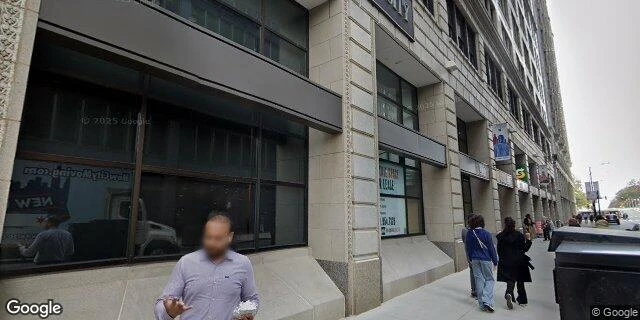
Attribution: © Google 2025
Building Info
- Square Footage
- 184,461 sqftHigher than 65% of all buildings1.5x median124,364 sqft1.4x median College/University135,042 sqft
- Built
- 1916
- Primary Property Type
- College/University
- Community Area
- Loop
- Ward
- 34
-
Chicago Energy Rating
- 2.0 / 4
- Owner

Note: Owner manually tagged. Logo used under fair use.
2023 Report Card
Debug Full Grade Data
- AvgPercentileLetterGrade: C
- AvgPercentileGrade: 50.408509504513184
- GHGIntensityLetterGrade: F
- GHGIntensityPercentileGrade: 13.335925349922237
- EnergyMixLetterGrade: A
- EnergyMixWeightedPctSum: 59.34599907603042
- EnergyMixPercentileGrade: 84.35136707388017
- SubmittedRecordsLetterGrade: A
- MissingRecordsCount: 0.0
- SubmittedRecordsPercentileGrade: 100.0
Emissions & Energy Information for 2023
- Greenhouse Gas Intensity F
- 9.5 kg CO2e / sqftHigher than 86% of all buildings1.5x median6.2 kg CO2e / sqft1.1x median College/University8.3 kg CO2e / sqft
- Total Greenhouse Gas Emissions
- 1,757 tons CO2eHigher than 75% of all buildings2.1x median841.4 tons CO2e1.6x median College/University1,104.4 tons CO2e
Years Reported
8/9
A

2015
2016
2017
2018
2019
2020
2021
2022
2023
Energy Breakdown for CDM Center
- Fossil Gas Use (aka Natural Gas)
- 6,827,105 kBtuEst. Gas Bill: $81,000 for 2023**Higher than 60% of all buildings1.2x median5,517,828 kBtu1.2x median College/University5,543,304.9 kBtu
- Electricity Use
- 9,966,088 kBtuEst. Electric Bill: $418,000 for 2023**Higher than 80% of all buildings2.8x median3,580,332.6 kBtu1.8x median College/University5,566,941.2 kBtu
Energy Mix A
Total Energy Use: 16,793,193 kBTU
Scan To Learn More
https://electrifychicago.net/building/cdm-center/
View Extra Technical & Historic Info
- Source Energy Usage Intensity
- Not Reported
This data was not reported for this building this year, which likely means a value of zero for this field.
- Site Energy Usage Intensity
- Not Reported
This data was not reported for this building this year, which likely means a value of zero for this field.
Full Historical Data Table for CDM Center
| Year |
Overall Grade |
Emissions Intensity Sub-Grade |
Energy Mix Sub-Grade |
Reporting Mix Sub-Grade | GHG Intensity kg CO2e / sqft | GHG Emissions metric tons CO2e | Energy Mix | Electricity Use kBTU | Fossil Gas Use kBTU | Source EUI kBTU / sqft | Floor Area sqft |
Chicago Energy Rating |
|---|---|---|---|---|---|---|---|---|---|---|---|---|
| 2015 | C | F | B | A | 16.1 | 2,966 | 64%Electricity 36%Fossil Gas 0%Other | 12,880,982 | 7,125,259 | 259.8 | 184,461 | - |
| 2016 | C | F | B | A | 15.5 | 2,854 | 65%Electricity 35%Fossil Gas 0%Other | 13,404,619 | 7,214,811 | 269.2 | 184,461 | - |
| 2017 | C | F | A | A | 15.1 | 2,790 | 65%Electricity 35%Fossil Gas 0%Other | 13,045,963 | 7,131,603 | 262.7 | 184,461 | - |
| 2018 | C | F | A | A | 13.9 | 2,563 | 59%Electricity 41%Fossil Gas 0%Other | 12,633,063 | 8,698,172 | 241.3 | 184,461 | 2.0 |
| 2019 | - | 11,565,895 | 8,759,916 | 225.4 | - | - | ||||||
| 2020 | C | F | A | A | 10.4 | 1,912 | 57%Electricity 43%Fossil Gas 0%Other | 9,755,558 | 7,334,714 | 189.8 | 184,461 | 3.0 |
| 2021 | C | F | A | A | 9.9 | 1,828 | 59%Electricity 41%Fossil Gas 0%Other | 10,165,600 | 7,081,958 | 194.6 | 184,461 | 3.0 |
| 2022 | C | F | A | A | 9.9 | 1,831 | 55%Electricity 45%Fossil Gas 0%Other | 10,466,288 | 8,528,172 | 207.4 | 184,461 | 2.0 |
| 2023 | C | F | A | A | 9.5 | 1,757 | 59%Electricity 41%Fossil Gas 0%Other | 9,966,088 | 6,827,105 | 190.1 | 184,461 | 2.0 |
* Note on Rankings: Rankings and medians are among included buildings, which are those who reported under the Chicago Energy Benchmarking Ordinance for the year 2023, which only applies to buildings over 50,000 square feet.
** Note on Bill Estimates:
Estimates for gas and electric bills are based on average electric and
gas retail prices for Chicago in 2021 and
are rounded. We expect large buildings would negotiate lower rates with
utilities, but these estimates serve as an upper bound of cost and help
understand the volume of energy a building is used by comparing it to
your own energy bills! See our
Chicago Gas & Electric Costs Source
for the original statistics.
Data Source:
Chicago Energy Benchmarking Data